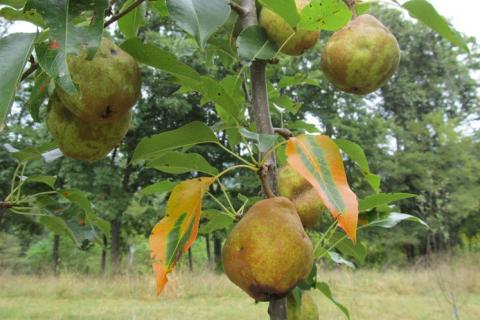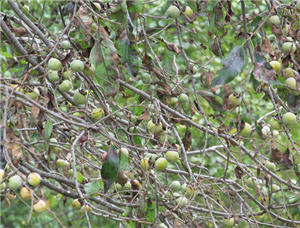
One of the most common problems deer hunters face is when bucks feel pressure on the usual feeding sites such as agricultural fields, food plots, and oak flats. Almost overnight, they can seem to vanish. When this happens, consider hunting near an alternative food source that’s often overlooked by most hunters: berry bushes, orchards, and scattered persimmon, apple, and pear trees.
 |
| Hunt for bucks like this wide 8 pt near scattered fruit trees and plan a careful stalk. photo courtesy Gerald Amy |
![]() Extra Tip: Fruit provides deer with nutrition, high levels of vital phosphorous, and a sugar-packed energy boost as they head into the strenuous period of the rut. It can also offer cover as well when thick-growing brambles such as blackberries and raspberries are involved.
Extra Tip: Fruit provides deer with nutrition, high levels of vital phosphorous, and a sugar-packed energy boost as they head into the strenuous period of the rut. It can also offer cover as well when thick-growing brambles such as blackberries and raspberries are involved.
Tactics for Hunting Deer in Different Fruit Setups
Hunting Deer in Isolated Fruit Trees
Hunt these before the rut and also after it when deer are searching for the last few sweet morsels of fruit heading into winter. Focus on scattered wild fruit trees or ones that survived around old abandoned farm sites such as pear, plum, apple, persimmon or crabapple.
Carry a topographic map or handheld GPS unit and mark where you find these scattered fruit trees. Search semi-open fields, old home sites, woods edges, fencerows, grassy areas, and brushy cover mixed with honeysuckle, saplings, and cedars. Confirm they are being used by locating fresh sign such as tracks, rubs and droppings.
Once you’ve pinpointed several trees holding ripe fruit and found fresh sign, plan your stalk. Usually there’s one route that will offer the best cover. Wait until the wind is perfect and use that approach.
![]() Extra Tip: If possible, choose a drizzly, damp day when ground cover won’t be noisy. Deer are also up on their feet and feeding more on these days. Alternately, choose crisp, clear cold-front weather when strong winds or frost have knocked fruits off trees overnight. Bucks will make a beeline for the freshly-fallen morsels.
Extra Tip: If possible, choose a drizzly, damp day when ground cover won’t be noisy. Deer are also up on their feet and feeding more on these days. Alternately, choose crisp, clear cold-front weather when strong winds or frost have knocked fruits off trees overnight. Bucks will make a beeline for the freshly-fallen morsels.
![]() Extra Tip: Glass as far ahead as you can, then ease slowly closer using all available cover. You may find a buck directly under the tree or in an adjacent thicket. Pick apart nearby brush and blowdowns carefully. A buck may be bedded in weeds and shrubs, digesting his snack before moving on to the next cluster of fruit trees.
Extra Tip: Glass as far ahead as you can, then ease slowly closer using all available cover. You may find a buck directly under the tree or in an adjacent thicket. Pick apart nearby brush and blowdowns carefully. A buck may be bedded in weeds and shrubs, digesting his snack before moving on to the next cluster of fruit trees.
 |
| Mature bucks will often vacate oak flats, ag fields and food plots and feed on stray fruit trees when they feel pressure. The sugar-filled food source helps prepare them for the rigors of the rut and winter. photo courtesy Gerald Amy |
Hunting Deer in Orchards
The second fruit setup dictates stand hunting. Here you’ve located an orchard, vineyard or abandoned farm that has a large stand of pears, apples, plums or grapes. These become daily feeding sites for deer because they know the ripe fruits will be eaten quickly by other animals if they don’t get there first.
In light of that predictable feeding pattern, your best bet is an ambush at the feeding site. Scout ahead and find where large fresh tracks, scrapes and rubs indicate a mature buck was feeding. Then study topos and satellite photographs to pinpoint the thickest nearby bedding cover where he’s approaching from. Face your tree stand so you cover that direction.
![]() Click here to view infographic How to Make the Perfect Buck Mock Scrape - LINK
Click here to view infographic How to Make the Perfect Buck Mock Scrape - LINK
![]() Extra Tip: Besides setting up a deer stand at the edge of the feeding site, also try to pinpoint a thinly-outlined trail heading from the orchard towards the buck’s likely bedding cover. Hang a stand downwind of that route, part-way back towards his daytime core holding area. Reserve that ambush site for use on hot days when he’ll likely move later and might not actually reach the fruit until it’s too dark to shoot.
Extra Tip: Besides setting up a deer stand at the edge of the feeding site, also try to pinpoint a thinly-outlined trail heading from the orchard towards the buck’s likely bedding cover. Hang a stand downwind of that route, part-way back towards his daytime core holding area. Reserve that ambush site for use on hot days when he’ll likely move later and might not actually reach the fruit until it’s too dark to shoot.
Hunting Deer in Bramble Thickets
Deer eat raspberry and blackberry fruits and also the plants’ leaves and stems. In fall, they’re also attracted to the thick, impenetrable cover the brambles offer. Look for clusters of these plants near fences, woods edges, clear-cuts and logging roads. The bigger the patch you find the more likely it will hold a mature buck.
Scout and locate as many such areas as possible with fresh sign. Then plan the best approach for each bramble patch using the wind and cover to your advantage to get within shooting range. Anticipate a quick snap shot as you move close to the fruit thicket.
Raise your firearm or bow quickly and shoot as the deer loads its legs for that first springing leap. Practice this type of shot ahead of time until you feel comfortable with it.
![]() Extra Tip: For an alternate approach to hunting blackberry thickets, try this method. Bring two buddies and position them near likely exit points where cover or brushy ditches offer potential escape routes. Then have another hunter slowly walk towards the bramble thicket. The approaching hunter may get a shot, or the buck may move past the hunters waiting at exit points, giving them a chance.
Extra Tip: For an alternate approach to hunting blackberry thickets, try this method. Bring two buddies and position them near likely exit points where cover or brushy ditches offer potential escape routes. Then have another hunter slowly walk towards the bramble thicket. The approaching hunter may get a shot, or the buck may move past the hunters waiting at exit points, giving them a chance.
With this technique be sure every hunter knows his or her safe shooting zones. And it goes without saying, during firearms seasons everyone should be wearing plenty of blaze orange!
![]() Watch Video: Hunting: Determining Your Safe Zone-of Fire - LINK
Watch Video: Hunting: Determining Your Safe Zone-of Fire - LINK
![]() Watch Video: Hunting: The Effectiveness of Blaze Orange - LINK
Watch Video: Hunting: The Effectiveness of Blaze Orange - LINK
- 3414 views

